Activation of different vestibular subnuclei evokes differential respiratory and pressor responses in the rat
- PMID: 12356893
- PMCID: PMC2290581
- DOI: 10.1113/jphysiol.2002.022368
Activation of different vestibular subnuclei evokes differential respiratory and pressor responses in the rat
Abstract
Activation of the vestibular system can either increase or decrease ventilation. The objectives of the present study were to clarify whether these different responses are the result of activating different vestibular subnuclei, by addressing three questions. Do neurones within the medial, lateral and spinal vestibular nuclei (VN(M), VN(L) and VN(S), respectively) function differently in respiratory modulation? Is the ventral medullary nucleus gigantocellularis (NGC) required to fully express the VN-mediated respiratory responses? Is glutamate, by acting on N-methyl-D-aspartic acid (NMDA) receptors in the vestibular subnuclei, capable of modulating respiration? In anaesthetized, tracheotomized and spontaneously breathing rats, electrical stimuli (< 10 s) applied in the VN(L) and VN(S) significantly elevated ventilation by 35 % and 30 % (P < 0.05), respectively. However, VN(M) stimulation produced statistically significant (P < 0.05) changes that differed depending upon the stimulation site: either ventilatory inhibition (by 40 % in 57 % of the trials) or excitation (by 55 % in 43 % of trials), and which were often accompanied by a pressor response. These electrical-stimulation-evoked cardiorespiratory responses were almost eliminated following microinjection of ibotenic acid into the stimulation sites (P < 0.05) or bilaterally into the NGC (P < 0.05). As compared to vehicle, microinjection of NMDA into the unilateral VN(M), VN(L) and VN(S) significantly increased ventilation to 74 %, 58 % and 60 % (P < 0.05), respectively, with no effect on arterial blood pressure. These data suggest that neurones within the vestibular subnuclei play different roles in cardiorespiratory modulation, and that the integrity of the NGC is essential for the full expression of these VN-mediated responses. The evoked respiratory excitatory responses are probably mediated by glutamate acting on NMDA receptors, whereas the neurotransmitters involved in VN(M)-mediated respiratory inhibition and hypertension remain unknown.
Figures

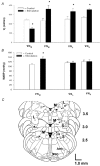
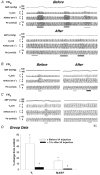
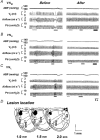
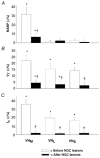
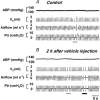
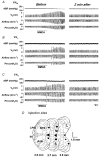
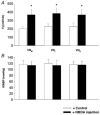
References
-
- Bassal M, Bianchi AL. Inspiratory onset or termination induced by electrical stimulation of the brain. Respiration Physiology. 1982;50:23–40. - PubMed
-
- Billig I, Hartge K, Card JP, Yates BJ. Transneuronal tracing of neural pathways controlling abdominal musculature in the ferret. Brain Research. 2001;912:24–32. - PubMed
-
- Bystrzycka EK, Nail BS. The source of the respiratory drive to nasolabialis motoneurons in the rabbit: a HRP study. Brain Research. 1983;266:183–191. - PubMed
-
- Chan SH. Arterial pressure- and cardiac rhythm-related single-neuron activities in the nucleus reticularis gigantocellularis (NRGC) Journal of the Autonomic Nervous System. 1983;13:99–109. - PubMed
-
- Chen LW, Yung KK, Chan YS. Co-localization of NMDA receptors and AMPA receptors in neurons of the vestibular nuclei of rats. Brain Research. 2000;884:87–97. - PubMed
Publication types
MeSH terms
Substances
Grants and funding
LinkOut - more resources
Full Text Sources
Research Materials

